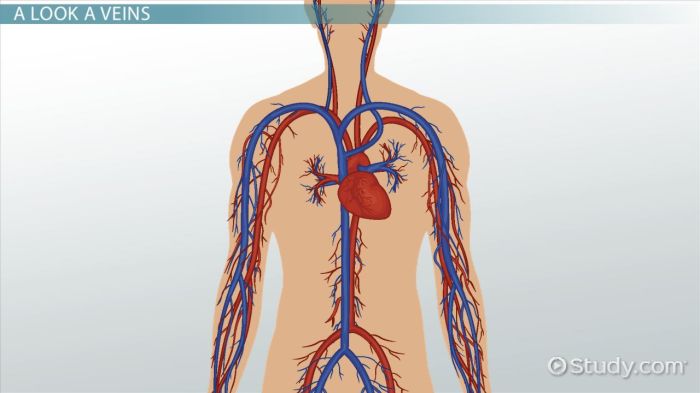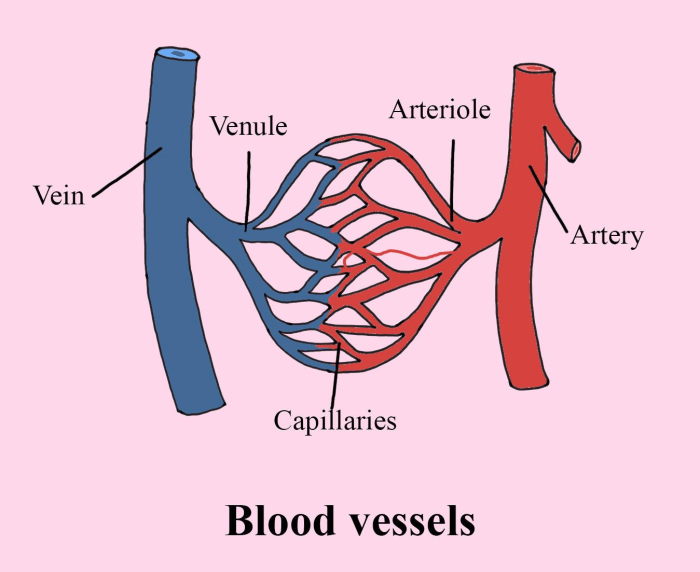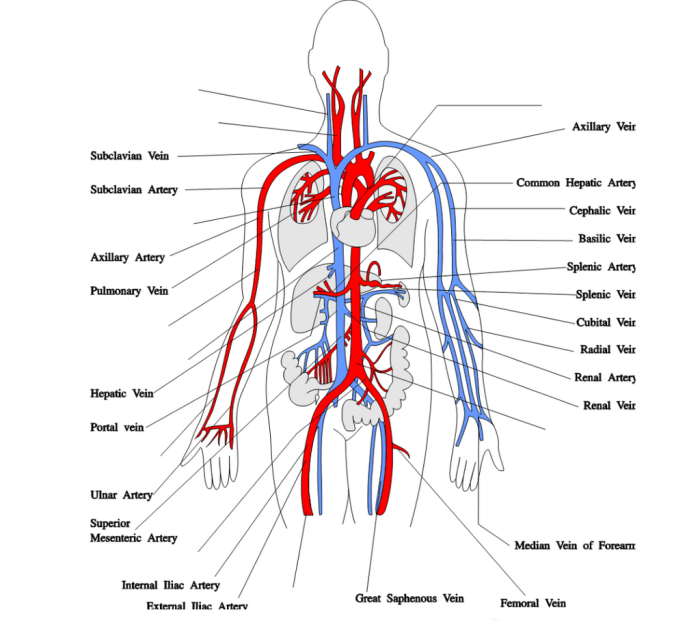Delve into the fascinating world of veins with our Veins of the Body Quiz! This comprehensive guide unveils the anatomy, functions, and clinical significance of these vital vessels, providing a deeper understanding of your circulatory system.
From the intricate network in your head and neck to the drainage patterns in your lower extremities, we’ll explore the diverse roles of veins in maintaining your health and well-being.
Major Veins of the Body
The venous system is responsible for returning blood to the heart. The major veins of the body include the superior vena cava, the inferior vena cava, and the hepatic veins.
Superior Vena Cava
The superior vena cava is a large vein that carries deoxygenated blood from the upper body to the heart. It is formed by the union of the right and left brachiocephalic veins. The superior vena cava enters the right atrium of the heart.
Inferior Vena Cava
The inferior vena cava is a large vein that carries deoxygenated blood from the lower body to the heart. It is formed by the union of the right and left common iliac veins. The inferior vena cava enters the right atrium of the heart.
Hepatic Veins
The hepatic veins are three veins that carry deoxygenated blood from the liver to the inferior vena cava. The hepatic veins are located on the surface of the liver.
The veins of the body quiz can be a tricky one, but if you’re looking for a challenge, I recommend checking out the New Mexico Unit 36 Elk quiz. It’s a great way to test your knowledge of the veins of the body and learn more about the anatomy of the circulatory system.
Veins of the Head and Neck

The veins of the head and neck are responsible for draining blood from the brain and other structures in the head and neck region. They play a crucial role in maintaining proper blood flow and preventing congestion in these areas.
Internal Jugular Vein
The internal jugular vein is the largest vein in the head and neck. It originates from the sigmoid sinus in the skull and descends through the neck, passing deep to the sternocleidomastoid muscle. The internal jugular vein receives blood from the brain, scalp, face, and neck.
It eventually joins the subclavian vein to form the brachiocephalic vein.
External Jugular Vein
The external jugular vein is a superficial vein that runs along the lateral aspect of the neck. It originates from the confluence of the posterior auricular vein and the retromandibular vein. The external jugular vein drains blood from the scalp, face, and neck.
It terminates by joining the subclavian vein.
Vertebral Veins
The vertebral veins are a pair of veins that run along the vertebral column. They originate from the vertebral venous plexus and ascend through the vertebral canal. The vertebral veins drain blood from the spinal cord, vertebrae, and surrounding structures.
Veins of the body quiz can be tricky, but they’re a breeze compared to the notoriously difficult NYS SBL exam. With its notoriously low pass rate ( nys sbl exam pass rate ), the SBL is a daunting challenge. So, if you’re feeling overwhelmed by veins of the body quiz, just remember that there are far more challenging exams out there.
Keep practicing, and you’ll ace that quiz in no time!
They eventually join the brachiocephalic veins.
Veins of the Upper Extremities
The upper extremity veins consist of the superficial and deep veins of the arm, forearm, and hand. The superficial veins are located just beneath the skin, while the deep veins are located within the muscles and fascia.
Superficial Veins of the Arm
The superficial veins of the arm include the cephalic vein, the basilic vein, and the median cubital vein. The cephalic vein runs along the lateral aspect of the arm, while the basilic vein runs along the medial aspect of the arm.
The median cubital vein connects the cephalic and basilic veins at the elbow.
Deep Veins of the Forearm
The deep veins of the forearm include the radial vein, the ulnar vein, and the brachial vein. The radial vein runs along the lateral aspect of the forearm, while the ulnar vein runs along the medial aspect of the forearm.
The brachial vein is formed by the union of the radial and ulnar veins at the elbow.
Drainage Pattern of the Axillary Vein
The axillary vein drains the blood from the upper extremity. It begins at the level of the shoulder joint and runs inferiorly through the axilla. The axillary vein then joins with the subclavian vein to form the brachiocephalic vein.
Veins of the Thorax

The thoracic veins are responsible for draining blood from the chest cavity. The main veins of the thorax are the azygos vein, hemiazygos vein, and intercostal veins.The azygos vein is a large vein that runs along the right side of the thoracic cavity.
It receives blood from the intercostal veins, bronchial veins, and esophageal veins. The azygos vein then drains into the superior vena cava.The hemiazygos vein is a smaller vein that runs along the left side of the thoracic cavity. It receives blood from the intercostal veins and esophageal veins.
The hemiazygos vein then drains into the azygos vein.The intercostal veins are a series of veins that run between the ribs. They receive blood from the muscles and organs of the chest cavity. The intercostal veins then drain into the azygos vein or hemiazygos vein.
Veins of the Abdomen and Pelvis

The veins of the abdomen and pelvis are responsible for draining blood from the abdominal and pelvic organs. The major veins in this region include the portal vein, splenic vein, and inferior mesenteric vein.
Portal Vein
The portal vein is a large vein that carries blood from the digestive organs to the liver. It is formed by the union of the superior mesenteric vein and splenic vein. The portal vein enters the liver at the porta hepatis and divides into right and left branches.
These branches then divide into smaller branches that supply blood to the liver cells.
Splenic Vein
The splenic vein drains blood from the spleen and pancreas. It joins the superior mesenteric vein to form the portal vein. The splenic vein is located behind the stomach and pancreas.
Inferior Mesenteric Vein
The inferior mesenteric vein drains blood from the descending colon, sigmoid colon, and rectum. It joins the splenic vein to form the portal vein. The inferior mesenteric vein is located along the left side of the abdominal aorta.
Veins of the Lower Extremities
The lower extremities have a complex network of veins that collect deoxygenated blood from the legs and feet and return it to the heart. These veins are divided into two main groups: the superficial veins and the deep veins.
Great Saphenous Vein
The great saphenous vein is the longest vein in the body. It begins on the dorsum of the foot and ascends along the medial aspect of the leg and thigh. It then passes through the saphenous opening in the fascia lata and empties into the femoral vein.
Veins of the body quiz? If you’re looking for some hand signs, check out the pi kappa phi hand sign . Anyway, back to the veins of the body quiz.
Small Saphenous Vein
The small saphenous vein is a much smaller vein that begins on the lateral aspect of the foot and ascends along the lateral aspect of the leg. It then passes through the popliteal fossa and empties into the popliteal vein.
Popliteal Vein
The popliteal vein is formed by the union of the great saphenous vein and the small saphenous vein. It then descends through the popliteal fossa and joins the femoral vein to form the common femoral vein.
Veins of the Heart: Veins Of The Body Quiz
The heart is supplied by a network of coronary veins that drain deoxygenated blood from the myocardium. These veins ultimately drain into the coronary sinus, which empties into the right atrium.
Coronary Sinus
The coronary sinus is a large, thin-walled vein that lies in the posterior atrioventricular groove. It receives blood from the great cardiac vein, the middle cardiac vein, and the small cardiac vein. The coronary sinus opens into the right atrium through the coronary sinus ostium.
Anterior Cardiac Veins
The anterior cardiac veins are a group of small veins that drain the anterior surface of the heart. They empty into the great cardiac vein.
Great Cardiac Vein
The great cardiac vein is the largest of the coronary veins. It drains the left atrium, the left ventricle, and the posterior surface of the right ventricle. It empties into the coronary sinus.
Clinical Significance of Veins

Veins, responsible for returning blood to the heart, hold significant clinical importance. They are susceptible to various conditions, including varicose veins and deep vein thrombosis (DVT), which warrant attention.
Varicose Veins, Veins of the body quiz
Varicose veins are enlarged, swollen veins that often appear twisted and bulging. They primarily affect the legs and are caused by weakened or damaged vein valves, leading to blood pooling and increased pressure within the veins.
- Causes:Prolonged standing, obesity, pregnancy, hormonal changes, and genetic predisposition can contribute to varicose veins.
- Symptoms:They may cause aching, throbbing, or heaviness in the legs, along with visible bulging veins, swelling, and skin discoloration.
Deep Vein Thrombosis
DVT occurs when a blood clot forms in a deep vein, typically in the legs. It can be life-threatening if the clot travels to the lungs, causing a pulmonary embolism.
- Causes:DVT is often associated with prolonged immobilization, surgery, certain medical conditions, and inherited clotting disorders.
- Symptoms:Swelling, pain, tenderness, warmth, and discoloration in the affected limb are common symptoms of DVT.
- Treatment:Treatment involves anticoagulant medications to prevent clot formation and extension, as well as compression stockings to improve circulation.
Role in Phlebotomy
Veins play a crucial role in phlebotomy, the process of drawing blood for medical testing. Selecting an appropriate vein and accessing it safely are essential for successful blood collection.
- Vein Selection:Visible veins in the antecubital fossa (inner elbow) are commonly used for phlebotomy.
- Access:Proper vein puncture technique minimizes pain and ensures blood flow into the collection tube.
Helpful Answers
What is the function of the inferior vena cava?
The inferior vena cava is responsible for collecting deoxygenated blood from the lower body and returning it to the heart.
What are the superficial veins of the arm?
The superficial veins of the arm include the cephalic vein, the basilic vein, and the median cubital vein.
What is the drainage pattern of the popliteal vein?
The popliteal vein drains blood from the lower leg and thigh into the femoral vein.